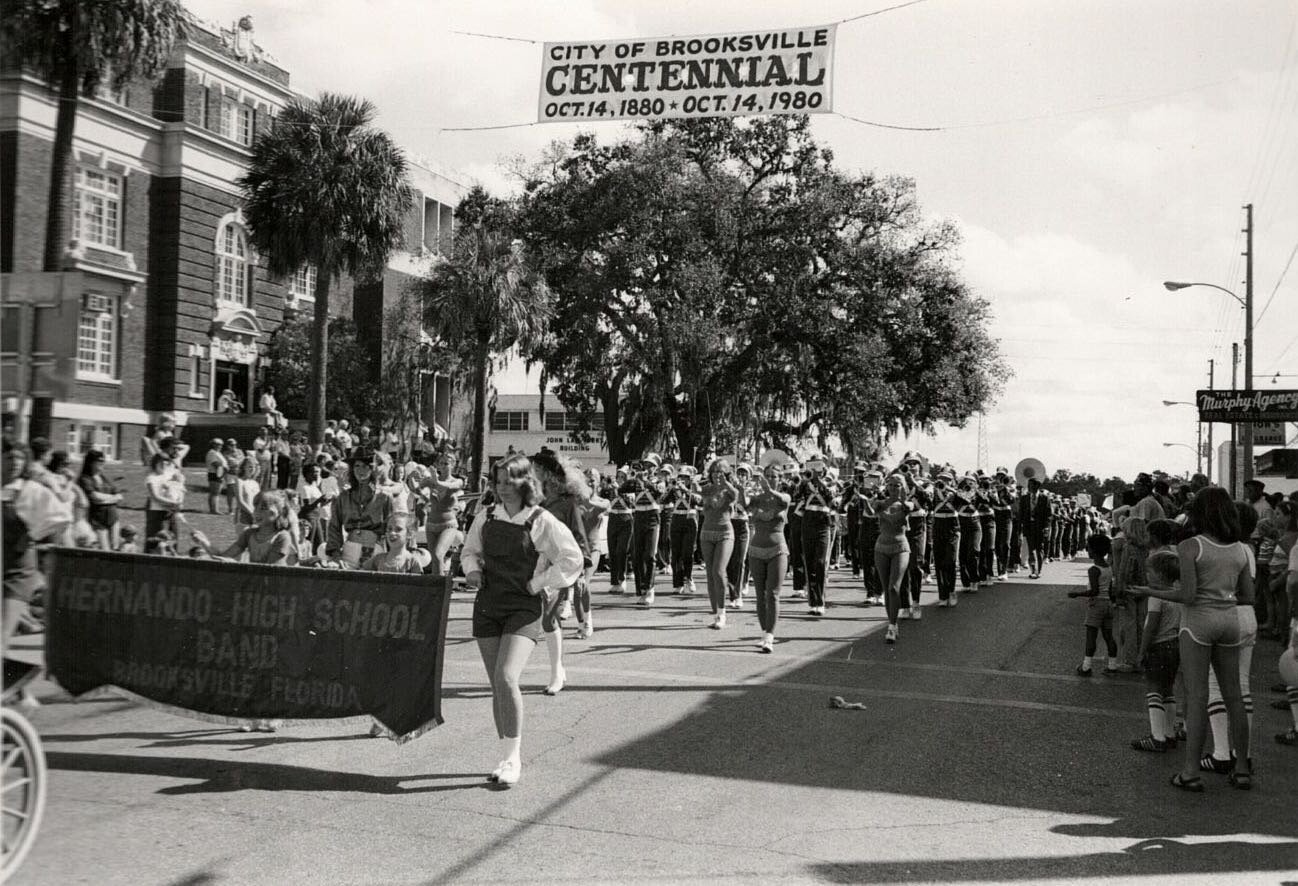
15 N Main Street
Address
11 & 15 N Main Street Brooksville, FL 34601
Year Built
1954
First Owner
J.G. McCrory
15 N Main
15 N Main, Bail Bonds, Warner
15 N Main, Centennial Parade (1980)
15 N Main, View North on Main
President Jimmy Carter in front of Lingles 5c & 10c during his campaign in 1976
Learn More about the Walking Tours
-
A Small Town’s Big Moment: Jimmy Carter’s 1975 Brooksville Campaign Stop
In the quiet streets of Brooksville, Florida, where the Hernando County Courthouse stands as a proud symbol of local history, a future president stepped into the spotlight in 1975. Jimmy Carter, then a relatively unknown former governor of Georgia, chose this small town for a campaign whistle-stop during his bid for the 1976 presidential election. With a warm smile and a message of hope, Carter spoke from the courthouse steps and mingled with residents outside Lingle’s Department Store, turning a routine campaign event into a moment of national significance for Brooksville. His visit not only showcased his knack for connecting with everyday Americans but also put this Hernando County gem on the map, proving that even the smallest towns can play a big role in shaping history.
Carter’s stop in Brooksville was no accident—it was a deliberate nod to the heart of small-town America. In 1975, he was an underdog in a crowded Democratic primary field, often met with the skeptical question, “Jimmy who?” But Carter had a plan: outwork his rivals and build a grassroots movement by visiting places others overlooked. Brooksville, with its population of around 7,000 and its rolling hills, fit perfectly into this strategy. As the Hernando Sun noted, Carter “spoke from the steps of the courthouse while campaigning in 1975,” a testament to his commitment to reaching rural voters. His speech, though details are scarce, likely echoed his campaign themes of honesty, reform, and a break from Washington’s status quo, resonating with a community that valued hard work and neighborly bonds.
Imagine the scene: the historic courthouse, built in 1913 with its red brick and white columns, framed by a crowd of curious locals. Carter, with his soft Southern drawl, stood on the steps, sharing his vision for a better America. Afterward, he strolled to Lingle’s Department Store, shaking hands and chatting with residents, his easy charm winning hearts. This wasn’t a flashy event covered by national networks—it was personal, authentic, and quintessentially Carter. His ability to connect in such intimate settings helped him build momentum, turning skeptics into supporters one handshake at a time. The Miller Center highlights how Carter’s strategy of entering every primary and caucus, including small-town stops, set him apart, ultimately leading to his surprise victory in the Iowa caucus and a strong showing in Florida’s March 1976 primary.
Brooksville’s moment in the spotlight was especially significant because it wasn’t a typical campaign stop. While Carter visited larger Florida cities like Miami, Naples, and Fort Myers, where he spoke to crowds and raised funds with Southern rock bands like The Allman Brothers, his choice to visit Brooksville showed his willingness to go off the beaten path. Florida was a make-or-break state in the primaries, and Carter’s decisive win over George Wallace in March 1976 proved his appeal across urban and rural divides. Brooksville, though small, contributed to this momentum, offering Carter a chance to lock in delegates and build a diverse voter base in a state critical to his nomination.
What makes this stop even more remarkable is its contrast with Carter’s other Florida appearances. In Naples, he spoke to a cozy group of 100 at the Cove Inn, and in Fort Myers, he stumped on the Lee County Courthouse steps before 500 people, railing against delays in Interstate 75 construction. Brooksville, however, was quieter, less documented, yet no less impactful. The lack of detailed records—perhaps tucked away in the Hernando Historical Museum Association’s archives—only adds to its charm as a hidden gem in Carter’s campaign trail. For Brooksville, hosting a future president was a point of pride, a moment when national politics met local life.
Carter’s visit also reflected his broader appeal to rural America, a key factor in his 1976 victory over incumbent Gerald Ford. His campaign raised $13.8 million, with events like a Florida fundraiser featuring The Marshall Tucker Band generating $280,000. However, it was his tireless travel—covering 200,000 miles, delivering 700 speeches, and shaking countless hands—that ultimately made the difference. This approach paid off, helping him secure 39.19% of the Democratic primary vote and the nomination at the 1976 Democratic National Convention.
For Brooksville, Carter’s visit was a brush with history that still resonates. The courthouse, dubbed “the Brooksville crown” by a local poet, has long been a stage for big moments, from William Jennings Bryan’s speeches in the 1900s to Carter’s 1975 address. The town’s role in Carter’s campaign underscores its place in Florida’s political tapestry, a reminder that even small communities can shape the nation’s future. Carter’s legacy as a president who championed human rights and peace lives on, but so does his legacy in Brooksville—a fleeting yet unforgettable moment when a peanut farmer from Georgia brought hope to a small town and carried its spirit all the way to the White House.
Citations
“The ‘Crown’ of Hernando County.” Hernando Sun, May 2, 2016. https://www.hernandosun.com/hernando_county_courthouse_2016_5_3.
“Jimmy Carter: Campaigns and Elections.” Miller Center. https://millercenter.org/president/carter/campaigns-and-elections.
“President Jimmy Carter: Did He Ever Visit Cape Coral, Naples or Fort Myers, Florida?” Yahoo News. https://www.yahoo.com/news/president-jimmy-carter-did-ever-032705894.html.
Ayres, B. Drummond, Jr. “1976 Surprise: Carter Is Running Well.” The New York Times, December 25, 1975. https://www.nytimes.com/1975/12/25/archives/1976-surprise-carter-is-running-well.html.
“Home - Hernando Historical Museum Association.” https://www.hernandohistoricalmuseumassoc.com/.
The Architecture
Masonry Vernacular: Flat roof, fixed windows, stucco exterior




